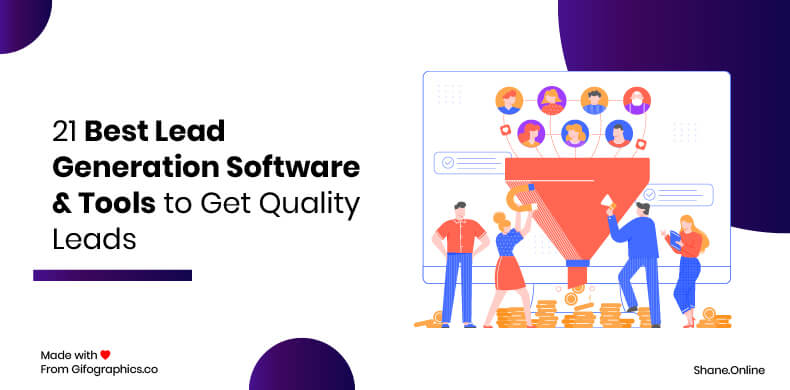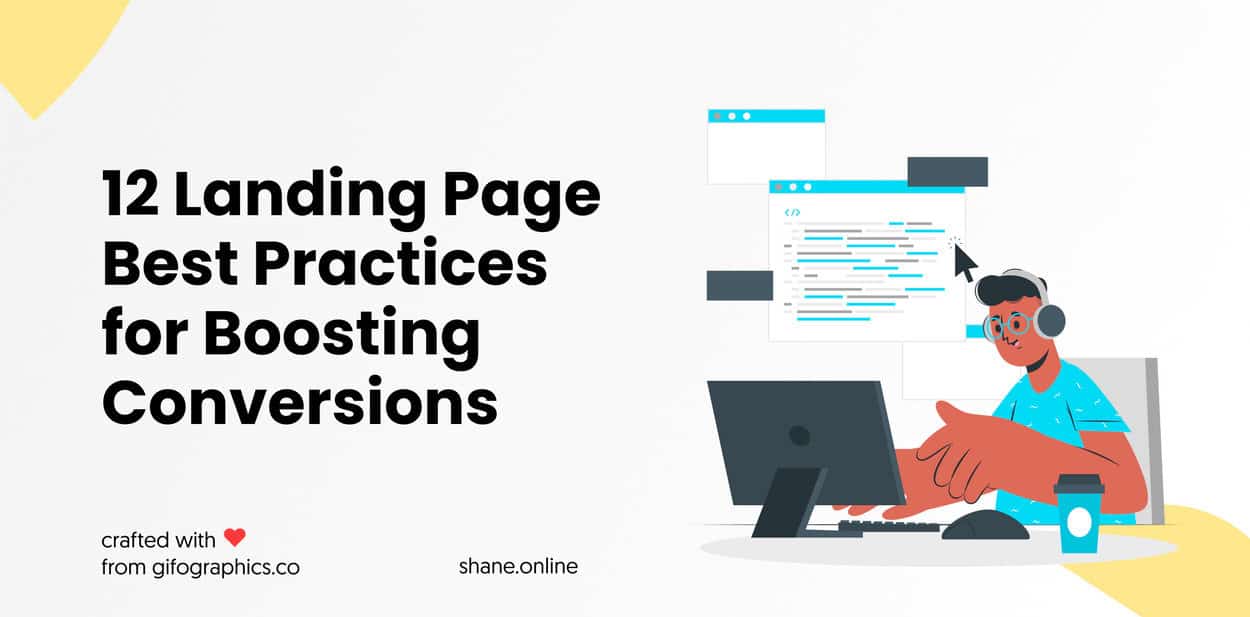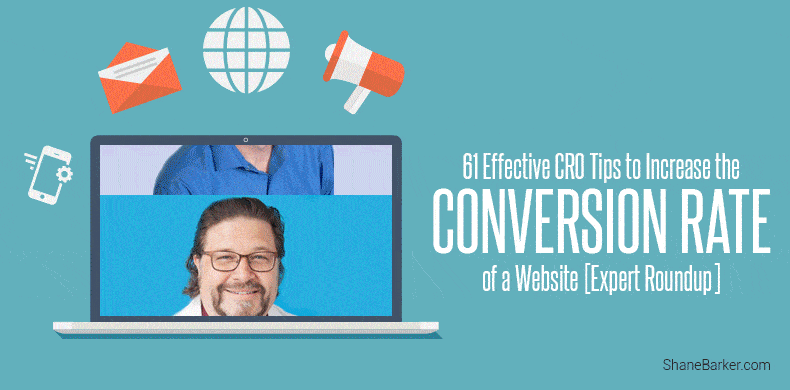As an ecommerce business, or for that matter any business, your primary focus should be on your conversion rate. Of course, I don’t mean you should undermine the importance of selling good products. Products that are valuable, and solve your customers' problems. However, you should continually look at ways in which you can increase your ecommerce conversion rate.
The competition in the ecommerce industry is huge. Especially with bigger players like Amazon and Walmart, it takes a lot of effort to build credibility. However, not many people know that a few key changes to your website can boost your conversion rate considerably.
Here’s my two cents on the best ecommerce conversion rate optimization strategies that you should focus on.
Table of Contents
1. Work on Your Security Signals
When a visitor lands on your website, organically or by clicking on your ads, give them reasons to trust you. They should feel confident about spending money on your products.
You need to clearly establish the fact that their credit card information will be handled securely. 19% of online shoppers don’t complete their purchase due to such trust issues.
A great way of doing this is by displaying security badges from Verisign or Bizrate. You can also think about installing SSL on your website, and at checkout. This can boost your ecommerce conversion rate, and also reduce cart abandonment.
2. Make the Experience as Real as Possible
Studies have found that 55% of people check product reviews before buying online. The same study also found that 26% of consumers visit physical stores to try the product before buying online.
Ecommerce doesn’t allow customers to touch and feel the products. So you need to work on making the experience as real as possible. This alone can do a lot to increase your ecommerce conversion rate.
Make sure to include high-quality images and videos too if possible. Include product reviews from customers who have bought the products. Also, make your product descriptions compelling. They should include details about how the product will be used, and by whom.
Don’t forget to include your unique selling point. The reason why customers should buy from you instead of others.
3. Provide Free Shipping
This might sound daunting, but trust me, this is what can really set you apart from your competition. 60% of online shoppers ditch their shopping carts due to additional costs like shipping and taxes.
If you’re able to generate relevant leads who are interested in purchasing from you, free shipping can ensure they provide you with a better ecommerce conversion rate. Think about it. The moment a potential customer sees that they’ll be charged for shipping, what stops them from going to Amazon?
I’ll even go a step further and recommend adjusting your product prices, if needed, to cover shipping costs. Because free shipping makes customers feel like they’re getting a great deal.
Final Thoughts
One thing is common to all of these strategies I’ve recommended. They put the customer first. If you can ensure that you are providing them a world-class shopping experience, they will definitely convert. For more useful and actionable tips on boosting your ecommerce conversion rate, check out these insights from experts.
#1. Olga Andrienko – Semrush

Check if the currency on your website matches your target country. It is so common that websites have an opportunity to change the country, but when changing the language, the currency doesn’t change.
Also, if you’re targeting different countries, choose the most relevant type of URL structure. Make sure the keywords you’re targeting match the keywords used in that country to search for what you have to offer.
Guest checkout. Make sure you have a guest checkout enabled through PayPal, and it will increase your conversion rate on a mobile device. Make it easy for people to purchase, don’t disconnect the shopping journey!
#2. Tracey Wallace – BigCommerce.com

Producing product videos for as many of your products as possible increases on-page engagement, which helps to boost your organic rankings. Plus, you can use those videos in re-targeting ads across Facebook, as well as on a YouTube channel to drive up CTR for searches on that platform and increase conversion rate.
Video gets you the biggest bang for your buck. It is becoming a must-have, not a nice-to-have. So knock it out in Q1 2018, and ride the wave for the rest of the year.
#3. Peep Laja – CXL Institute

Do it any other way and you're only putting on lipstick without tackling the issues that would actually many you money and improve user experience.
#4. Bryan Eisenberg – Buyer Legends, LLC

One way to leverage this for brand affinity, traffic and conversion rate is online video. I hope ecommerce businesses invest in creating videos that not only inform but entertain as well. Move past boring flat product images, and simplistic product videos to better scripted info-tainment videos.
#5. Nir Eyal – NirAndFar.com

Ecommerce retailers need to find ways to make interacting with their companies a consumer habit for better conversion rates.
In 2018, retailers need to remember that without a habit, the competition can always undercut them on price while loyalty is a competitive advantage. Build user habits into your product experience or bolt-on content marketing or community management to keep users engaged with your brand even when they're not ready to buy.
Remember, monetization is a result of engagement, not the other way around.
#6. Brian Massey – Conversion Sciences

Forget big data. This is data on the desktop, at the fingertips of every marketer and product manager in the organization. Of course, it's not about the tools. The people using them make the difference.
The lab will incorporate inexpensive, easy-to-use tools, including analytics, user testing, heatmapping, session recording, and AB testing. In 2018, your team must learn to use these tools. In 2019, it will be too late. In 2018, awaken the scientists in your team.
#7. John Lincoln – IgniteVisibility

On the product page, the eCommerce store should recommend 2 to 4 other items the user would also be interested in purchasing, and if possible, also have an option to buy all three and show the savings associated with that.
Another strategy I recommend is an upsell in the checkout process. For example, after the customer selects their item, the next page shows special offers related to the product and showcases the discount.
Finally, after the customer has converted is another opportunity. On the confirmation page, you can add text that says “Your Product Has Been Purchased. Buy These Products In The Next 3 Minutes For 40% Off.” A post sale ecommerce conversion rate optimization strategy can be really effective.
My last one (I could go on for a while on this topic!) Is to add your top sale items to your 404 page. I did this with a client and saw an increase in ecommerce conversion rate of over 15% sitewide, and it was a pretty large site.
#8. David Skok – ForEntrepreneurs

#9. Tommy Walker – Shopify.com
With nearly every analytics setup, there is something that is misconfigured that does not give you full visibility into your customer journey. Are you properly tracking your goals? Do you know which events lead to sales? Are your traffic segments tracking repeat purchasers? Are you looking at what people who search your site are doing? Or people who enter your site through specific categories, product pages, or information pages?
Analytics that are finely tuned to your business needs will give you incredible insight into exactly how people are using your site, and reveal gaps that can serve as the foundation for testing hypothesis, or obvious improvements that need to be made in your ecommerce conversion rate optimization strategy.
#10. Andy Crestodina – Orbit Media Studios

Suggest products relentlessly without taking them out of their flow. The cart is a fantastic place to offer companion products since they've already expressed buying intent. Every additional purchase here just adds to the bottom line for better conversion rate of your ecommerce business.
#11. Dennis van der Heijden – Convert.com

I think many forms will have to be tested in 2018 on how to get the email while making sure each person gives the consent on how to use that information. It will dive a more conscious customer and surely will increase the power of the consumer and increase conversion rate for your website.
Most marketing systems will be affected and I predict we will see a whole new range of A/B test cases on our Convert.com platform, where GDPR had a big say in the UX and outcome of the test.
#12. Michael Kawula – DinnerTableMBA

There are tons of live chat tools available to improve conversion rate of ecommerce websites, but if you’re using any of them, is your company collecting and using that data of conversations taking place?
These conversations and questions being asked will show you what needs to be tweaked on each and every page of your site to help get better conversion rate and convert new visitors to customers.
Really dive into all those conversations and you’ll notice patterns of areas where visitors are getting stuck and that will show you what to fix.
#13. Talia Wolf – GetUplift.co

Unless you start making it about the customer, understand their challenges, needs and expectations you will never be able to create the experience your customers will love to convert to.
Stay data-informed, understand where the story is, but go deeper. Get to know your customers, get into their heads and run customer-centric tests, tests that tell you more about your customers and what they need. Forget about call-to-action buttons or headlines, amazing results can only be achieved when you run meaningful tests to achieve better results in your ecommerce conversion rate campaigns.
#14. Aaron Orendorff – Shopify Plus

What's especially important to understand are the friction points where B2B buyers drop out of your funnel. In an increasingly self-service world — where B2B shoppers are well over 50% through a purchase before reaching out to directly to suppliers — aligning your social-media profiles (both branded and individual sales people) with organic-traffic entry points (SEO) with your “into-the-funnel” opt-ins is crucial.
What's equally crucial is creating gated content focused on aligning multiple stakeholders. You can do this by tracking link-clicks (UTMs) within gated assets — like PDFs — and measuring the engagement of different people at the same organization through your CRM.
#15. John Rampton – Calendar.com

#16. Sam Hurley – OPTIM-EYEZ

Personalization:
The demands of customers are more intense than ever before. Big brands are innovatively delivering exceptional, optimized experiences that are now becoming the norm; at least, in the customers' eyes…
Tools are available to completely tailor websites (and surrounding content, including ads) to the individual — so ecommerce stores definitely need to take heed and start acting on this, if not already. It's the path to seamless 1:1 communication, at scale.
“81% of consumers want brands to get to know them and understand when to approach them (and when not to).”
(Source: Accenture)
Chatbots and virtual assistants are equally powerful tools to equip in any ecommerce conversion rate optimization kit. The buzz surrounding them is justified. They can be used to aid customers throughout their entire journey, even up-selling and cross-selling along the way…
The good news? Such technologies are becoming less expensive (and easier to use) as the industry grows, so it's definitely worth the investment. They are proven to dramatically increase ecommerce conversion rates — and consequently, profits.
“89% of businesses report improved results from personalization.”
(Source: DealerRefresh)
Present shoppers with the specific products and content they want to see (exactly when they want to see them.)
Website Speed:
In a world of shortened attention spans, not much needs to be said here!
In addition to demands, customers NEVER want to wait. Not for anything…
Load fast, or lose customers!
NOTE: Focus particular attention towards your checkout process. Is it completely pain-free? Don't lose all traction at the last hurdle!
#17. Kath Pay – Holistic Email

Your email database contains your target market, so use email’s unique push ability and treat every email as a survey by asking your customers what they like via a scientific A/B testing program in order to achieve success in your ecommerce conversion rate strategy.
By seeking long-term valuable insights through email marketing, you not only increase results within email marketing but you can share them across other channels to drive the business objectives that are common to all channels.
Apply what you've learned to your website copy and organization, to your search keywords, PPC campaigns and related landing pages, and in ads and banners you run on third-party sites in remarketing or network campaigns.
Email gives you a good basic testing structure that you can build on to sharpen your insights and improve your marketing efforts bit by bit across all channels. It's another one of email's superpowers that marketers so often overlook or ignore.
Ultimately, it's another reason why investing both time and money in email pays off across your entire marketing program.
#18. Nichole Elizabeth DeMere – Zest.is

Not just in being able to target ads ever more precisely, but in more companies figuring out how to really hone their messages through accurately identifying their ideal clients, doing the on-the-ground research to find out what they need, want and are missing, and creating entire experiences – ads, landing pages and products are the tip of the iceberg here – around them.
There are some brick-and-mortar stores that are nailing this in ways ecommerce stores are only beginning to understand. You might even call it the “Cheers” effect – everybody knows your name, and when you come in the door, you feel like family.
That is what personalization can be, and that is what will be providing better results in conversion rate as consumers learn that they can expect that level of experience.
#19. Daniel Burstein – MECLABS Institute

In our survey of 2,400 customers, the most frequent way unsatisfied customers described the marketing of the company they were unsatisfied with is “the company does not put my wants and needs above its business goals.”
A Conversion Rate Optimization tool ecommerce marketers can use to increase conversion rate by putting the customer first is the MECLABS Institute Conversion Sequence Heuristic. It is a thought tool to use as you work on webpages and marketing and help you increase the probability of conversion rate. You can get a closer look at this thought tool at MECLABS.com/heuristic.
#20. Anna Talerico – ion interactive

Secondly, continuing to focus on testing the merchandising, especially the mobile experience shows better ecommerce conversion rate results. As we buy more online we need to be able to get up close and personal with the merchandise. How it's presented is key, especially on mobile.
#21. Josh Coffy – Flight Media

They're incredibly effective and very cheap to set up. In fact, Facebook Messenger is now one of the most-used means of communication, often more than texting and Whatsapp – with open rates often in the 80% range with click-through of 5-15%.
With Facebook Messenger Bot tools, like Many Chat, you can set up automated “message” sequences to drip content to people via Facebook Messenger and automate conversations with potential customers or current customers to increase conversion rate of your ecommerce website.
If you don't use messenger bots, you're leaving thousands on the table that can affect in your ecommmerce conversion rates.
#22. Mandy Edwards – ME Marketing Services

Let’s talk appearance first. Are you using high quality, appealing images? Are these images inviting? You want these to draw your customer in and entice them to click.
Ugly, low quality images never do that. Is your site clean and easy to read, or is it cluttered and flashy? You will lose customers if they feel overwhelmed by the content on your site and thus hinder your conversion rate stats.
How about analytics, especially Google Analytics. If you are not using Google Analytics to track traffic on your website, stop what you are doing right now, bookmark this post, and go set it up.
You need to know where your traffic is coming from, who is visiting your site, how long they are on your site, and if they put items in a cart and left. Consistently monitoring your site’s analytics will tell you if your efforts are working and if you need to adjust your ecommerce Conversion rate strategy.
#23. Graham Charlton – SaleCycle

#24. Rachel Pedersen – RachelPedersen.com

I’m not just talking about testing button colors or fonts… Drastic split tests that will polarize the results and find something unexpected.
For example, the difference between a graphic and a stock photo or between a lifestyle photo and a testimonial could be dollars per acquisition.
My personal favorite split tests include; using vastly different imagery for banner ads and Facebook, copy that is clickbaity vs. long form copy, and even split testing a market that you didn’t previously realize could yield major results (younger, older audiences, male vs. female).
The more money you spend on traffic, the quicker the data becomes apparent, and you will quickly realize the difference in price and how it adds up in your website conversion rate!
#25. Chris Makara – Bulk.ly

But before you start implementing and testing, you need to be 100% sure you are tracking and documenting changes made to your site. Without it, you'll have no idea what is or isn't working on the site.
When it comes to ecommerce conversion rate strategy, I typically like to make deliberate changes one at a time in order to really know what is impacting overall conversions. And I prioritize the checkout process.
Of course different markets respond to different things, but I find that implementing (or at least testing) the option to checkout as a guest opposed to having to create an account almost always wins out. This is because there is less barriers for the buyer to overcome.
They have to give you their name, shipping info, payment info and email at a minimum anyway. But since they aren't forced to create passwords, verify email addresses, etc. they typically feel less pressured and are more than happy to hand over their basic details.
The next thing I would prioritize in my ecommerce conversion rate strategy is how you do pricing. If it is more than $100, try testing where you don't use decimals in the price. The reason is that when you “speak” out the price it is more words and can feel more expensive to a buyer than a flat number without decimals.
This can lead to more perceived value of the product and elicit more buyers to take action.
In 2018, I would start with these two ecommerce conversion rate strategies and measure the results. If they prove successful, look at ways you can improve them even more.
#26. William Harris – Elumynt.com

I also think more ecommerce stores will realize the value in offering payment terms for their merchandise. A lot of people don't realize how hard it is for millennials to get credit cards and build up any substantial credit profile. Companies like Sezzle.com don't require a credit check, and make it easier for millennials to purchase from their favorite stores.
#27. Tink Taylor – dotmailer.com

My advice for 2018 would be to fully optimize the way you collect users’ data via your store for your website's conversion rate. Introducing a smart popover is one of the best ways to make this happen because you can choose where and when it’ll appear on your site.
An advanced tool will let you measure performance and continually improve your ecommerce conversion rate so that you can endeavor to gather an email address from everyone who visits your website.
#28. Marcus Miller – BowlerHat

So the best conversion rate strategy can be to go back to basics and develop a better understanding of your customer.
At my agency, Bowler Hat, we are big fans of the SOSTAC digital marketing framework. The Situation Analysis (S) component here will help you really dive into your customers and competitors. From here you should be able to identify opportunities to offer more value than the competition. And this value proposition should be key to your approach when trying to convince more visitors for better ecommerce conversion rate results.
Then, with this strategic knowledge in place you can start testing different offers and calls to action to put your theory to the test. Then, you can dive into analytics and the more traditional elements of ecommerce conversion rate optimisation – but make sure you get the marketing basics 100% dialed in first.
#29. Erik Emanuelli – NoPassiveIncome.com

When you look at your ecommerce website, answer this question:
“Does it satisfy my audience needs?”
Each of your web pages are aimed to attract, educate, convert or finalize the purchase.
Focus on keeping your users on the website. Use amazing pictures, add informative videos, create product guides, showcase positive reviews to increase the conversion rate of your ecommerce website.
Invite buyers with free shipping, or particular discounts or gifts.
The purchase process should be smooth, from selecting the product up to the shopping cart.
It's all about user experience and the added value you can give to your audience.
#30. Matt Janaway – Marketing Labs
Conversion Rate Optimization tip #1: Install Live Chat & use it!
It’s a well-known fact that today’s online shoppers prefer to message. 2017 was the year of live chat and 2018 should be too!
Nearly every day I see an eCommerce website where a live chat plugin or integration could help convert more visitors into customers. It is also a great tool to help visitors contact your business without having to pick up their phone, which in turn reduces the strain on your customer service team (if you have one!).
Live chat can also uncover repeat customer queries which can then be fed back to your design time to implement in order to increase ecommerce conversion rate of your website.
There are bundles of free live chat plugins and integrations available, I highly recommend live chat software such as ZenDesk or Tawk. If your eCommerce website is based on WordPress, these two options both offer one-click WordPress plugin integrations that you can add yourself without the need for developers.
Conversion Rate Optimization tip #2: Improve your product descriptions
I’m 99% sure your product descriptions suck. I’m yet to see an eCommerce store with product descriptions that can’t be improved in terms of content, layout and user experience (UX).
If your customer service team is wasting time answering product related customer queries, your product descriptions have failed – big time! I’m always telling eCommerce owners and webmasters that they need to imagine their product descriptions as an in-store assistant – first, think like your customers and then answer every possible question within the description.
Improving your product descriptions is a long and relentless process (even for businesses with a dedicated web team!), so if you’re struggling for time in 2018, try and write 3-7 detailed bullet points for every product. I promise your ecommerce conversion rate will increase.
Conversion Rate Optimization tip #3: Improve your product images
We all know that product images sell and with just 8 seconds to engage with the average website visitor, your product images need be hot and I’m talking super hot!
Your images need to be professional, show off the product from multi-angles and show the product in a “real-life situation.”
If you want to go all-out, try and get your hands on product pictures from your customers and drop these into your product pages. Social proof has been proven to increase ecommerce conversion rates time and time again.
So, go away and take some new product photos…you could even start a competition with your customers to send you photos of their product using an engaging #hashtag!
#31. James Scherer – Wishpond

Putting advertising to the side, I'm confidently recommending to ecommerce clients that they ad list-building popups to their websites as soon as possible – welcome mats/entry popups, scroll-popups, header or footer opt-in bars, etc.
All these optimize your ecommerce website for better conversion rates to capture lead information. This enables you to send not just abandoned cart emails, but also emails about an upcoming sale or limited-time promotion.
As a bonus, capturing lead information before someone buys also means you can simplify your checkout process (often reported as one of the primary reasons people don't complete checkout). There's no account creation necessary.
#32. Khalid Saleh – Invesp

2018 will bring in new complexities in conversion rate optimization for ecommerce websites. Consumers expectations are ever changing. They no longer accept generalized and generic offers. They want a personalized experience.
Consumers have too many options to choose amongst. Most services and products have been commoditized. If you want to compete online, you must focus on creating a personal and unique relationship with your customers.
With the advent of technology, there is a tendency to automate and generalize everything. The challenge will be to find the right balance of when to use general solutions and when to introduce personalized shopping experience to online visitors.
Start thinking and adapting to voice search:
Back in 2009, we talked about the growth of mobile websites. Some marketers predicted that eventually, most of the web traffic would be coming on mobile devices.
That day is here now. Voice search is next frontier. 20% to 30% of searches are done using voice search. This trend will continue to grow.
How does that impact ecommerce? Voice search allows your potential customers to ask specific questions and to expect quick and personalized answers to help them make a purchase decision and increase the conversion rate for your ecommerce website.
In addition to adapting your ecommerce technology to meet visitors’ expectations, we might see trends of less browsing and more direct navigation to match visitor query. How would store layout, navigation and search change to meet that new trend? It is too early to tell, but one thing you can bet on is that this will be a topic of heavy discussion in 2018.
#33. Danny Halarewich – LemonStand

There's no shortage of conversion rate optimizations and ideas to grow your eCommerce business that you can use to grow revenue and profit.
But, before implementing specific ecommerce conversion rate optimizations, you should ensure you are doing a great job of the basics because that is most often where the biggest opportunities for growth will be found.
Is Google Analytics installed and tracking correctly, including eCommerce and checkout conversion rate data?
Do you have clear reporting on how your business is doing today? What has worked well so far? What hasn't? Did you hit your previous goals? Why or why not?
What are your specific, measurable goals for 2018?
Have you tested your ecommerce website, especially the path to purchase, across multiple web browsers and devices to look for bugs, confusing text or visual blockers? If anything is broken, prioritize that first in ecommerce conversion rate strategy.
Run speed testing tools against the main pages of your website, and make fixes and improvements accordingly. You don't need a perfect score, but aim to get as close as possible. Address any quick wins immediately, and schedule larger improvements.
Review customer feedback, questions asked in customer service, and complaints. If you don't have feedback to review, prioritize gathering that feedback from customers ASAP.
After that, there are some more specific second-level areas you can evaluate:
- Shipping: Study after study show that many customers don't complete their purchase because of expensive or confusing shipping charges. Is your shipping charges clear and simple to understand? Have you carefully considered offering a free shipping option? If that's not possible, can you offer simple flat rates?
- Product Images: Are your product images professional, and high resolution? Do you show multiple photos for each product? Do you include photos showing the product being used and enjoyed by customers?
- Product Descriptions: Are your descriptions detailed, clear and on-brand? Does your copywriting use language that matches how your customers describe your products?
- Checkout: Do you allow guest checkout with as little friction as possible? Is each page or section of the checkout simple and clear? Is visually secure, and use HTTPS on the checkout (and other pages)?
- Live Chat: Implementing live chat makes customers feel more comfortable making a purchase, knowing they can speak to a real person. It's also a great way to glean insights from visitors by learning what questions and objections they have, which can inform further areas of improvement in your ecommerce conversion rate optimization strategy.
After evaluating those areas, note down specific items for each that can be improved and tested for betrter conversion rate results. Implement, measure, learn, then repeat.
#35. Jamie Turner – 60SecondMarketer.com

But in the end, the only thing that matters on a landing page is your ROI and trust badges can help improve your ROI. How?
Studies show that your ecommerce conversion rate will increase 10% or more when you use a trust badge. Given that, you should use them wherever possible. After all, adding a trust badge is like putting money in your pocket, and that's a good thing for your ecommerce conversion rate, right?
#36. Shanelle Mullin – Shopify

Go beyond the hacks and tactics. Rely on a less sexy, but more effective systematic process to achieve desired ecommerce conversion rate results. The process is a bit different for everyone, but it should look something like this:
1. Conduct qualitative and quantitative research on your unique site to identify problem areas.
2. Use your research to come up with test and experiment ideas.
3. Prioritize those test and experiment ideas using a prioritization method like ICE or PXL.
4. Begin running the highest priority test or experiment.
5. Analyze the results of the test or experiment.
6. Record or archive the results of the test or experiment.
7. Use the insights from your most recent test or experiment to come up with smarter test and experiment ideas.
If you focus on this, I genuinely believe you'll be among the top 30% of successful ecommerce conversion rate optimizers.
#37. Jim Sterne – ai4marketing.com

Just like the World Wide Web in the early 1990's, AI and machine learning are going to significantly change marketing and now is the time to poke it with a stick and think about how it can help you. And, it can help you today.
#38. Dennis Yu – BlitzMetrics

You can build funnels, examine audiences, and run ads across all your channels, not just Google Analytics (which is only for your website).
Go play in the demo account to see how to set up your Facebook analytics account.
Then compare your referrer, goal path, and session reports between Facebook analytics and Google Analytics. You'll find significant differences, since Google is measuring based on cookies, which don't account for people using multiple devices — therefore, dropping and over-counting sessions by about 41% of your social traffic.
Now you get to see the true impact of your Facebook efforts on your ecommerce conversion rate efforts.
#39. Sean Si – SEO Hacker

Good images: With the rise of the Apple brand accentuating the need for “feel” and “presentation,” a good image can turn a “want” to a “need,” if you can get a higher resolution image that is curated to make sure your audience see what they need to see regarding the product, do so.
You can’t imagine how many shops I’ve been to that literally had something that looked copy pasted from Google images page. Instant bounce.
Customer feedback: In the age where websites are popping up everywhere, social proofing is very necessary for a sale as it builds trust to your brand using third-party credentials.
When people see people buy, they are more inclined to trust the seller and let loose of their inhibitions against the risks of online transactions. Make sure to get their name at the very least and a picture would be the definite magnet to this feature in order to improve conversion rate of your ecommerce website.
Smoothen your checkout: Different people prefer the different process of checkout, from laying out every form to fill out face front to separating them into segments, then test which one works best for your customers.
But overall the rule of thumb is to get only what you need at the time that they are about to pay. The more friction you have in that moment, the more they have time to hesitate to make a sale.
Security signals: This is the most important ecommerce conversion rate optimization strategy that gets overlooked a lot but makes a significant difference. Give your site the subtle comfort of security by making sure you have SSL and that green padlock icon at your address bar plus the icons of that builds trust such as the different credit cards, Paypal and McAfee, Geotrust etc.
Provide Valuable Content: On the product page especially. There are a lot of shop owners who feel like the “picture says it all” but I highly believe otherwise. Dimensions and technical details of the product will always encourage the customer that they are buying “just what they need.”
Always go the extra mile to think what the customer would want to see, a different angle on the picture? Specifications? Size? Length? Expiry date? etc. Try as much as possible to compensate based on the lost senses they might use in a physical shop to buy the product
Allow anonymous checkout: As counter-intuitive as it seems, sometimes some people just need something on your site and that’s all. In these cases make sure to allow anonymous checkup to remove just another friction in the checkout process.
Keep the registration optional but make sure to emphasize it’s benefits such as order tracking and better customer support.
#40. Laura Pence Atencio – SocialSavvyGeek

At Social Savvy Geek we use ManyChat to automate some of our messaging and we have had an overwhelmingly positive reaction.
The key to this tactic is to keep things simple, give people what they really need from you, and always, always offer human help. Automation is great – until it isn't.
Much like email automation sequences, ChatBot sequences are a great tool as long as you don't overdo it. Getting the conversation ecostarted and helping people in real time using a bot is a win for everyone as long as you let people know that you're doing it and that they are welcome to move on to human interaction whenever they need a more personal interaction.
If it's appropriate to your brand, a little humor never hurts, either.
#41. Ayat Shukairy – Invesp

Strategic experiments require significant pre and post-test analysis. They also require significant time and level of effort. Tactical testing is quick to implement and requires less effort.
2018 must bring in a new commitment to implement the right conversion rate optimization program. For those who dabbled in split testing but never committed, it will be the time to seriously consider what it would take to start a conversion rate optimization program.
For those who have been doing some testing, the new year should allow them to evaluate their program. Are they following a meaningful strategy? What kind of results did they see? And finally, how can they improve their program.
#42. Jordan Kasteler – JordanKasteler.com

#43. Matt Thorpe – Grasshopper UK

Data is everything to an ecommerce business but it's only valuable if you use it in the right way.
Stores need to focus on providing a more personalized experience with their welcome series for increase in ecommerce conversion rate. They need to collect more data and then use it to tailor the on-boarding content that adds real value, instead of a one-size-fits-all approach. The first 90 days of the relationship is critical but they must impress and engage from day 1.
Customers have so many emails fighting for attention in their inbox but the ones that deliver value and solutions to their problems are the ones that will be seen. It's also much easier to sell to someone who loves what you do already.
#44. Drew Sanocki – Nerd Marketing

You have to think about how users interact over time, and be able to identify deviations from standard purchasing behavior. The more you can correct those deviations, the better your Conversion Rate will become.
#45. Cameron Conaway – Reflektion

It sounds like common sense, right?
The best way to do it, especially for ecommerce sites with extensive product catalogs, is to use an AI-powered platform that can understand and even optimize your product catalog while it creates unique profiles based on every individuals' preferences and intent.
Unfortunately, most ecommerce sites are lagging woefully behind. Some are complacent and unwilling to change their legacy processes (which are often based on antiquated segmentation models), and many others think artificial intelligence too nascent to offer them any value.
Providing a truly individualized customer experience both for anonymous or logged in users (and whether they are on your site or checking their email) isn't a hack, nor will it give barely noticeable ecommerce conversion rate gains.
Customers are increasingly expecting such experiences, and conversion rates often increase upwards of 20% for brands that deliver.
#46. Nicholas Scalice – Earnworthy

Remove everything that could detract from getting a visitor to click on that “Buy Now” button.
For instance, do you really need 5 different social sharing links above the fold on your ecommerce website? Focus on the elements that will bring better conversion rate results, such as testimonials, product reviews, trust seals, and great images.
#47. Tiffany daSilva – Flowjo.co
HANDPICKED RELATED CONTENT:
Now the big secret? Do the whole process again, but now with your competitors. You can even do a whole user testing strategy where you ask them to go to your competitors first, and then end the test with your own ecommerce website (or include it somewhere in the middle). This way you can get different perspectives and see how your website holds up against your competitors.
Pro tip: Don't be afraid to stack your ecommerce site against a big website. They obviously have more money and resources, but you may learn little things about what you do well vs. not so well in comparison.
The only way to grow to that level is to know which changes to prioritize and getting an outsider perspective on what's important to them will help you do that.
#48. Stewart Rogers – VentureBeat.com

AI can create its own hypotheses, run tests, measure the results, and pick the winners faster and better than any human can, so it will be important for all marketers and ecommerce project managers to embrace AI in the coming year.
Embracing AI means that marketers can focus on applying their skills in more creative areas, leaving the ecommerce Conversion Rate Optimization tools to handle high-waste, menial tasks.
#49. Grant Thomas – Justuno

First and foremost, implementing a list building strategy will maximize the return from your current traffic acquisition campaigns. You’re spending all of this time, effort and money to drive traffic to your site but the harsh reality is that the majority of this traffic will not convert into a sale upon that initial visit.
If you can capture an email from that visitor, then you’ve opened up a lane of communication for future marketing efforts and gained value from driving that traffic in the first place.
As I mentioned earlier, capturing an email has a widespread effect on ecommerce conversion rate optimization. Your most effective tactics to drive a shopper to purchase rely on having that shopper’s email. Cart abandonment, browse abandonment and other lifecycle email campaigns are highly effective driving sales but you need an email to run these campaigns.
Another major benefit of building your email list is having a larger number of interested leads to market to during key sales dates and holidays.
Think about the value that more email leads holds when Valentine’s Day, Mother’s Day, Halloween, Cyber Weekend and other major shopping periods throughout the year. You can even upload your email lists to Facebook and create custom audiences for retargeting ads.
Email marketing boasts an ROI of up to 40X so feeding your most powerful marketing channel is a must in 2018.
So add an email popup to your website and start converting shoppers into subscribers! Engage shoppers upon entry and exit or create your own display rules based on your strategy. Email list building can make a huge impact on your ecommerce conversion rate optimization in 2018 so hop to it!
#50. Frederick Vallaeys – Optmyzr

Managing shopping ads on AdWords is very different from managing keyword-targeted ads so here are some things we recommend to increase ecommerce conversion rate:
1. Add negative keywords to shopping campaigns.
While there isn't a way to target shopping ads by keywords, you can at least eliminate underperforming queries with negative keywords. For example, find queries that have gotten clicks from multiple ad groups and eliminate the query in the ad group where it underperforms.
2. Bid more granularly, specifically by setting bids for each item.
To do this you'll need to maintain a GRIP structure (groups of individual products). Too many advertisers combine many items in a single product group and this makes granular bid management impossible.
3. Bid based on common attributes that drive good performance.
When you maintain a GRIP structure, it may sometimes be hard to get enough data to set good bids. In these situations, do an analysis of commonalities between products. E.g. find what size shoe drives the best ROI, or what combination of color and brand drives the most sales.
4. Avoid spending money on “everything else.”
If you change the products you sell, or even how you categorize products in your feed, you can create a disconnect between the merchant feed and your AdWords structure and when this happens, your volume of traffic to generic catch-all product groups may rise.
This is bad because it takes away your ability to bid smartly. So pay attention to keeping your AdWords structure in sync with the feed so that most of your traffic is to defined product groups, and again, ideally to groups of individual products for optimized conversion rate.
#51. Kirk Williams – ZATO

After constant “mobilegeddon” and “year of mobile” pronouncements for the past few years, this won’t be the popular answer. But I believe it’s the answer where the most significant and immediate increases in Ecommerce Conversion Rate Optimization improvement can happen.
Studies showed a significant rise in mobile purchases this year over the 2017 holiday season.. purchases, not simply visits! Consumer behavior is finally shifting to an increased comfort level of buying on their mobile devices, yet overall website design and UX still leaves a lot of room for improvement on many ecommerce websites.
If you want to invest in a Conversion Rate Optimization strategy with significant gains in 2018, make sure your visitors can purchase your products easily, and quickly, on their mobile phones (tested for 3G!) and watch overall ecommerce Conversion Rates rise.
#52. Jon MacDonald – The Good

They can start by identifying the main pathway visitors take to purchase through qualitative (user testing, session recording) and quantitative (analytics, heat/click/scroll mapping) data. And then use that data to focus on encouraging visitors to take a preferred customer journey to a conversion.
I detail which analytics reports to review, and how to get visitors to follow the intended path to purchase, in an article on my company, The Good conversion rate optimization blog.
#53. Keegan Brown – Megethos

My first recommendation is for ecommerce sites to get up to speed with traditional digital marketing and supplement your products with quality content. No longer can you just throw up a site with some products and expect to grow your conversion rate.
This is especially true for sites with a longer sales cycle or big ticket items. Use a variety of content such as blogs, videos and images to educate your users on your products.
This also includes user generated content. Customer reviews and testimonials on your product and checkout pages send great trust signals that help convince a user at the time of a purchasing decision.
Secondly, make your checkout process easier. This seems basic part of ecommerce conversion rate, but as a consultant and consumer, I constantly see this missed across a variety of ecommerce sites.
There are several tactics to do so like letting users checkout as guests or letting them use a digital wallet such as Apple Pay or Paypal. As mobile devices keep trending upwards, the shorter the process the better.
#54. Ryan BeMiller – Shopping Signals

The basics include things like: Improving site speed; ensuring good user experience; providing high quality, yet web-optimized product photos; updating product descriptions so they focus on the benefits to the customer… not on the features and specs of the product; and of course, offer free shipping if at all possible.
Beyond the basics, I think the most important Conversion Rate optimization strategy is to focus on simplifying the checkout process as much as possible.
You can achieve this by doing things like: eliminating any unnecessary fields for the user to fill out; reducing the number of steps and/or pages in the checkout process; adding a progress indicator to show the customer where they are in the checkout process; and being as transparent as possible (as soon as possible) about shipping time and cost.
Studies have shown that the earlier in the checkout process a customer knows the shipping cost and time details, the less likely they are to abandon cart.
#55. Lori Taylor – LoriRTaylor.com

Tracking and analytics to track LTV is everything. And the best way to improve Conversion rate optimization is to create one-on-one targeted communications with your customer.
From micro segmentation for emails triggered by purchasing behavior to integration of your buyers into dynamic facebook retargeting campaigns – the most important activities to focus on are post click conversations and engagement.
The more specific you are with your customers the higher your Conversion rate optimization will be.
#56. Shep Hyken – Hyken.com

The shortest distance between two points is a straight line, so be careful about adding extra screens or pop-ups with promotions in order to optimize your website for better conversions. Up-sells are important, but you must keep the user experience simple, direct and clean.
In addition, give your customer confidence. If the customer stumbles during the sales process, you need to be there to pick them up. Have a way to contact sales and customer service support on every page. That might be a phone number or a live chat.
#57. Sean McQuaid – Instapage.com

For example, sell an inexpensive sample set and throw in free shipping. These low-cost offers have high CTRs and conversion rates because they require little commitment from customers. Buffer in a tiny margin, and you can help offset the cost of running the ads.
This conversion rate optimization strategy will build a customer database for re-marketing higher margin products, and it will lower your customer acquisition costs.
Get personal in 2018:
We all want offers tailored to us. Scale the click-through landing pages that are tied to your ads and emails to create personalized post-click experiences. This leads to increased conversion rates and stronger brand affinity.
Improve checkout flows using session playback:
Product teams have traditionally used session playback tools like FullStory to improve customer experiences. More marketing teams should leverage session playback for Conversion rate optimization to better understand customer journeys and improve checkout flows.
#58. Angi Bowman – Lucky Orange

When you start to put a priority on your audience rather than conversion rate, you set yourself on track for gathering valuable insight and feedback that you can then use to your advantage.
For example: With the rise of mobile, do you know how mobile users are really scrolling through and navigating your website? You already know that mobile should be a priority, but does your website reflect that conversion rate stats?
The best Ecommerce Conversion Rate Optimization strategy is to keep your audience in mind as you view dynamic heatmaps. Segment data to isolate mobile users and find what they are missing and how they are actually clicking on elements, such as drop-down or hover-over menus.
Take this information and combine it with form analytics or user recordings to then validate a newly-implement one-click checkout process or change a form to better bit the users' wants.
What that said, it’s also time to ask your audience to engage with you. Launch a poll asking what stopped users from checking out today, and activate live chat to engage users before they leave your website.
Live chat can be especially helpful for smaller eCommerce stores with limited resources and time. It’s already been known to increase conversion by at least 20%, and the vast majority of today’s users prefer it to other methods of communication.
The point is to get to know – really know – your audience and listen; just listen! Your audience will tell and show you exactly what is working and what they want from your eCommerce store. The more you do this, the more you’re going to win over the long haul in your ecommerce conversion rate strategy.
#59. Jeff Sauer – jeffalytics.com

And when you prove that this method works than generic marketing or trying to buy your way to the top, then you can scale. Put gasoline on the fire with paid advertising, and start to build these relationships at scale and increase your conversion rate.
#60. Jeff Gibbard – JeffGibbard.com

Find the one that's the most broken and fix it. Look for ways to reduce friction, and keep in mind that not everyone is ready to buy, so start planning to have content for each stage of the buyer journey.
#61. Brad Geddes – Adalysis

For years, forcing account creation was a no-no for conversion rate optimization and you could easily double your conversion rates by not forcing account creation. Unfortunately, this was taken too far and a lot of companies gave up on users having and managing accounts.
With mobile purchases, no one wants to retype out the same information every time. When a user first purchases, auto create an account for them (of course, asking if they want their credit card data saved). Don't make account creation optional – just make the account for the user. Upon repeat visit, checkout is much faster.
On mobile, we see users with smaller baskets than with desktops; however, they buy more often. Embracing the quick repeat buyers on mobile can dramatically improve the bottom line in your ecommerce conversion rate strategy.
#62. Richard Lazazzera – A Better Lemonade Stand

Going into 2018, ecommerce stores should be looking to expand their contact with customers beyond email to increase their conversion rates. In particular Facebook Messenger chatbots look like a great supplemental strategy, with their 80%+ open rates.
#63. Krista Park – Greenlane

In addition, we’d like to consider how each of the factors (channels, et al) influence return rate, repeat purchases, and brand usage later on.
In essence, we’re adding focus and emphasis to the sub-actions of the cart, and giving more attention to the longer term relationship with our consumers.
Ultimately, we believe learning more about this portion of the funnel and their impacts on the longer term relationship will go a long way to increase the conversion rate, brand advocacy and loyalty.
#64. Steve Chou – mywifequitherjob.com

The first thing you must get right is your checkout process. All forms should utilize address autocomplete using the Google Maps API.
You almost must have a payment processor in place that can import a customer's payment and address information automatically such as Paypal, Apple Pay or Amazon Payments. If a user has to type a lot of text on their tiny keyboard, you have a high chance of losing the sale.
Finally, thanks to Amazon, free shipping is par for the course. If you don't have a reasonable free shipping tier, people will abandon immediately, affecting the conversion rate of your ecommerce website.
#65. Erin Bury – Eighty-Eight

While influencer marketing is typically paid promotion, if you target your outreach, you can find people who will talk about your product without compensation as long as it fits with their target demo.
While you can track which influencers are driving sales through unique promo codes, you can also try using an affiliate marketing platform like Cake to allow influencers to make a cut on each product they sell through their audience.
It provides more incentive for them to share, and continue sharing, your product, and can be a great way to turn one-time influencer posts into ongoing ambassador relationships to improve the website's conversion rate.
#66. Tor Refsland – TorRefsland.com

1. The niche of your ecommerce store
2. Your target audience (read: avatar)
Even though this might seem like common knowledge for most ecom owners, it's still surprising to see how few that actually implement that knowledge into their Conversion Rate Optimization strategy.
You should look at your product page as a mini landing page.
If your strategy is to do paid traffic to the product page, it should focus on one single thing: conversion to sale.
If your strategy is to do organic traffic to the product page, the focus should be SEO optimization WITHOUT lowering the conversion rate.
There's no point in organic traffic to a product page, if it doesn't convert.
Obviously exit-popup, countdown timer and scarcity of stock will increase the conversion. That being said, it's important that the countdown timer is real, and the same goes without saying about the limited stock.
People are fed up by the evergreen marketing tactics that all the so-called gurus preach.
2018 is the era of transparency and ethical marketing. Keep that in mind when doing your Conversion Rate Optimization, and you will not only make sales, but you will build a fan base of loyal customers that will love your brand and products.
Needless to say, that will increase your average customer lifetime value.
#67. Ron Sela – Ron Sela Consulting

Adding the recent changes that Facebook has just announced regarding the news feed posts display, and it’s an adapt or die kind of situation.
If you want to optimize your Conversion Rate Optimization during these tough times, here are two things to consider.
First is using chatbots and conversational marketing in the selling process. The typical marketing metric you’re used to measuring is the quantity, not the quality of your work.
The best way to measure the quality is to ask your clients personally to speak their minds. Those who know the honest needs and reviews of their clients are those who will win the market because they’ll adapt and improve the fastest.
For this reason, chatbots are a great way to keep in touch with your clients and prospects, as long as you provide them value.
Second is providing value throughout the funnel. No one likes when they’re sold something, but everyone wants to buy.
Some marketers understand that principle, but only halfway through – they provide value for free before the selling happens, and then they keep spamming the new client with selling offers. Think of your customers as of friends – simply give them information or free samples of your work because you care about them.
#68. Chris Dayley – Disruptive Advertising

Testing things like scrolling add to cart buttons on your mobile experience can go a long way in simplifying the user experience for mobile users and provide better ecommerce conversion rate results.
#69. Paul Rogers – Vervaunt

#70. Sam Thomas Davies – Sleeknote

#71. Raphael Paulin-Daigle – SplitBase

It's still shocking to see how many companies create their customer personas based on internal brainstorming sessions and opinions. In the process of doing so, a whole lot of assumptions are created, and when it's time to create marketing materials, they're more often than not based on these assumed customer personas.
The result is copy, images, and a message that doesn't resonate with the customers as much as it should.
In order to have a website and ads that truly resonates with the target audience, it's important for companies to call and talk to their customers every day and send qualitative surveys often.
When you understand what their daily lives look like, what pushed them to buy your products (or what made them hesitate), and how they describe, in their own words, your brand; you've got a powerful database of insights.
This will help you decide what A/B tests to run, what information to add to your product pages, and ultimately, will help you increase website conversions.
We've routinely seen 20%+ lift in sales by optimizing product pages based on these customer insights. In other words, ignore this at your own risk.
#72. Giles Thomas – Acquire Convert

Sources like customer development interviews (thanks Steve), customer service transcripts, live chat transcripts with Olark and more provide great yields in your ecommerce conversion rate optimization strategy. Crunch this data with my three step method as seen here and make changes to your personas, value propositions and ultimately profits!
#73. James Norquay – Prosperity Media

1. Ensure you have fantastic demo videos on your product pages.
2. Ensure you use customer rating on product pages and make use of customer reviews.
3. Ensure you have a quick and effortless checkout process, do not force users to register to buy.
#74. Ian Moyse – Natterbox

A key Conversion Rate Optimization strategy for 2018 must be to analyze rapidly and regularly, change quickly when needed and be agile to change repeatedly, personalizing the experience where required to different personas.
The biggest tripwire to ecommerce is going to be stagnation; being chained to slow irregular changes through process, technology or effort constraints.
#75. Adam Gray – social-experts.net

An analysis of customer needs and a robust “customer journey mapping” session* is a great starting point…but it’s only ever a starting point.
No matter how much time and effort has been invested in the strategy that you have you should be prepared to throw it away and start again if it isn’t working.
I think that too often we land on what we think is a really good idea and then just cling on to it rather than acknowledge (as early as possible) that it isn’t really working. So that bravery and flexibility are paramount.
In the same vein, the question is quite a difficult one to answer because to assume that without understanding the product, the marketplace and the region that a previously very successful strategy used somewhere else will work for you is skating on thin ice. So a healthy dose of explorer is needed!
Don't believe what you see without facts. Opinions are a dime a dozen…only numbers are facts.
So, in a nutshell, I think that your best conversion rate optimisation strategy is:
1. Be flexible. Don’t assume that tried and tested ideas will work…because they probably won’t
2. Prove it. Make sure that you have the data to support your assumptions, split testing everything is the only way to get the best performance from any campaign.
3. Make sure that you remember what the required outcome is. Ask the sales department (rather than “brand”) what they want because sometimes the end justifies the means **
it’s amazing how many “customer journey mapping” sessions I’ve sat in on over the years without having seen a customer! Don’t make this mistake.
** for example, irrespective of what your company font is, according to well known copywriter Courier is the best typeface for mailers, and Direct Mail written in Courter yields a 15-20% better return than those that aren’t. Who knew!
#76. Stephen Monaco – Stephen Monaco, Inc

For instance, countdown timers naturally create a sense of urgency. At the same time, feigning urgency when it doesn’t actually exist rapidly erodes trust with prospective customers; no one likes being lied to. Decades of scientific research has proven people are prone to block out messages of urgency unless they are provided with information on how to follow up.
Equipped with the proper info on how to follow up, people are 25% more likely to perform the desired behavior prior to the deadline.
Dozens of Magnetic Resonance Imagery (MRI) studies have shown how highly active the prefrontal cortex of the human brain becomes when people are thinking about having to wait for things, which is terrible for conversion rates.
With that in mind, conversions can skyrocket when you cause people’s brains to instantly “light up” by focusing on the types of instant gratification they crave. Incentives to buy are triggered by focusing on how your offerings provide immediate relief from their pain points, fast shipping, instant access, etc. Point out how easy it is for them to do business with you so they can get started immediately.
Example: “Start now and get your first 30 days free; no credit card required. Cancel at anytime.”
Finally, deep down, human beings long for a sense of belonging, to be part of larger movement, and want to stand for something that resonates with their own values and belief systems. Behavioral studies indicate when people are labelled as being part of a specific group it nudges them to take actions that are in-sync with others that are members of that community who share some of the same characteristics in your conversion rate optimization strategy.
#77. Simon Penson – SimonPenson.co.uk

I'm fascinated by how the user journey is moving front and centre of digital again and for Conversion Rate Optimization that's no different. By designing and working on nurture and designing content journies that make the consumer/visitor smarter we will see improvement in conversion rate thanks, in no small part, by Google's increasing intelligence now around attribution and intent.
To crack it you must think about your marketing plan in a completlely different way, putting people back front and centre and spending a LOT of time in research to understand how they move through your ‘space'.
#78. Branden Moskwa – nadimo.com

Simplification of the checkout process so as to eliminate any congestion or blockages needs to be the focused element of your ecommerce conversion rate optimization strategy in 2018. The easiest win in to remove redundancies and unnecessary form fields. The next best is to deploy various strategies focused specifically on autocompletion of address fields.
Cart abandonment is high, don’t lose the sale when they are already on the way to the til, and worse don't make them frustrated with an overly cumbersome checkout process leaving them either with and abandoned cart or, arguably worse, as a one time shopper no repeat shopper.
#79. Dennis Seymour – leapfroggr.com

1. Live Chat Support
Instant and personal. It lets the potential buyer see how you help them (trust) and it's instant feedback. It also gets you leads if ever they leave the site.
2. Using a Chatbot
I am in love with chatbots. I would actually build a really robust ecommerce conversion rate focused bot and test that or let it handle most of the front end support until they request for live chat help from real people. It also helps if you could use the Facebook Messenger platform, which allows you to market to them even outside your site.
3. Awesome Site Structure and Speed
Your website SHOULD load fast and the structure says a lot about your site as well. If it's easy for them to navigate, there's a good chance they will add something to the cart and search for more stuff to purchase. This also helps with your SEO and you already know how important it is in your conversion rate optimization strategy.
#80. Gareth O'Sullivan – GarethOSullivan.com

With user-generated content (UGC) becoming a big hit this past year, brands should consider using UGC as part of their 2018 strategy. You might consider using this type of content on the landing page, the checkout page, or even on most of your website's pages to show that people trust you.
I've come across a lot of ecommerce stores that have already implemented this conversion rate optimization strategy and it's the way forward to increase social trust. Various research has proven that people trust other customers more than the brand itself.
B2B companies can also take in on this strategy by using client testimonials with their client's logos providing they have permission.
If you aren't already implementing UGC as part of your strategy, you might be missing out on some easy quick wins. Don't be afraid to implement more Conversion rate Optimization strategies, let 2018 be your year.
#81. Aljaz Fajmut – nightwatch.io

The second major ingredient in the optimal Conversion rate optimization strategy is establishing outreach to influencers. Ecommerce businesses should be focusing on developing relationships with influencers in their niche to get them write, retweet, and spread the word about their companies and products.
Ideally, influencers would become “amplifiers” for the content that ecommerce companies publish — or even write guest posts for them.
The additional ingredient in the mix is the strengthening the inbound content, which can be spread through paid advertising methods such as PPC, Facebook ads, or any ad platform relevant to the business.
#82. Rafael Lourenco – ClearSale

Most merchants would be surprised at the number of declined transactions that are hurting their bottom line in achieveing their desired conversion rates' goals. These fraud filters may be provided to merchants through their payment processor, ecommerce platform or even with a third-party solution.
They use a variety of screening mechanisms to identify fraudulent transactions, including IP geolocation, e-mail checking, external data sources, device fingerprinting, AVS check, and more.
While the intention to root out and prevent fraud is good, there are many problems with fraud filters that lead to good transactions getting denied. With no human review, the likelihood of false declines increases dramatically, and the layering of different fraud rules could result in contradictions that lead to auto-decline of transactions, which not only loses the sale, but also risks customer loyalty and brand reputation.
Focusing on finding a fully managed solution would help merchants practically eliminate false declines and drastically increase conversion rates.
#83. Shayla Price – ShaylaPrice

Work with your team to learn what helps your customers. Consider moving from a multi-page checkout to a single-page. You may include a product summary to ensure buyers are making the right purchase. Think about adding security seals to give customers peace of mind that their credit card information is safe.
Testing your checkout page is a two-fold benefit. It helps improve the customer experience, and as a result, you'll earn more revenue in your ecommerce conversion rate strategy.





![41 best tools for building a profitable sales funnel in [year] 167 41 best tools for building a profitable sales funnel in 2021](https://shanebarker.com/wp-content/uploads/2020/08/41-Best-Tools-for-Building-a-Profitable-Sales-Funnel-in-2021.jpg)
![top 37 cro tools (free & paid) you need to try in [year] 168 top 37 cro tools (free & paid) you need to try](https://shanebarker.com/wp-content/uploads/2018/02/Top-37-CRO-Tools-Free-_-Paid-You-Need-to-Try.jpg)



Awesome!! very useful. Keep it up.
Thank you so much. I’m glad you loved reading my blog about conversation rate optimization.